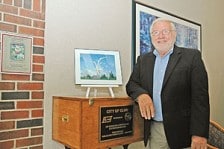A trout stream ahead, a city not far behind
.floatimg-left-hort { float:left; } .floatimg-left-caption-hort { float:left; margin-bottom:10px; width:300px; margin-right:10px; clear:left;} .floatimg-left-vert { float:left; margin-top:10px; margin-right:15px; width:200px;} .floatimg-left-caption-vert { float:left; margin-right:10px; margin-bottom:10px; font-size: 12px; width:200px;} .floatimg-right-hort { float:right; margin-top:10px; margin-left:10px; margin-bottom:10px; width: 300px;} .floatimg-right-caption-hort { float:left; margin-right:10px; margin-bottom:10px; width: 300px; font-size: 12px; } .floatimg-right-vert { float:right; margin-top:10px; margin-left:10px; margin-bottom:10px; width: 200px;} .floatimg-right-caption-vert { float:left; margin-right:10px; margin-bottom:10px; width: 200px; font-size: 12px; } .floatimgright-sidebar { float:right; margin-top:10px; margin-left:10px; margin-bottom:10px; width: 200px; border-top-style: double; border-top-color: black; border-bottom-style: double; border-bottom-color: black;} .floatimgright-sidebar p { line-height: 115%; text-indent: 10px; } .floatimgright-sidebar h4 { font-variant:small-caps; } .pullquote { float:right; margin-top:10px; margin-left:10px; margin-bottom:10px; width: 150px; background: url(http://www.dmbusinessdaily.com/DAILY/editorial/extras/closequote.gif) no-repeat bottom right !important ; line-height: 150%; font-size: 125%; border-top: 1px solid; border-bottom: 1px solid;} .floatvidleft { float:left; margin-bottom:10px; width:325px; margin-right:10px; clear:left;} .floatvidright { float:right; margin-bottom:10px; width:325px; margin-right:10px; clear:left;}
By the time all of the pieces are in place for the transformation of Clive’s congested Northwest 86th Street, Mayor Les Aasheim could be ankle deep in a remote Idaho trout stream.
Aasheim has decided that after nine years as mayor and nearly 14 years as a city councilman, it is time to step aside.
At age 71 and “pushing 72,” Aasheim, who also served 22 years as principal at Stillwell Junior High School in West Des Moines, has plans to visit children and grandchildren who are scattered across Iowa and as far east as Massachusetts.
He plans more trips to that Idaho trout stream, where a 50-mile Forest Service road leads to a six-mile backpack into scenic and rugged mountain country.
“If you like to fly fish, invariably almost everyplace you go is beautiful,” he said one day, while casting an eye along the north-south route of Northwest 86th Street.
It is a stretch of road that would barely earn an “attractive,” let alone a loftier description.
But it is a street in transformation, and for that Aasheim deserves some credit.
“I have taken a great deal of interest in 86th Street,” he said.
And for good reason. The street provides a major entrance to the city and a link with West Des Moines on the south and Urbandale on the north.
Yet it has served as a pipeline to move vehicles through the city at the rate of about 35,000 a day. Making a turn across traffic and into businesses along the road has been problematic. Traffic flow at its intersection with Hickman Road is 65,000 vehicles a day.
A lot of people are going somewhere on Northwest 86th Street, and Aasheim and other city leaders would like for them to stop and spend some time.
Change is under way, and Aasheim talks about current improvements and future achievements in practically the same breath.
He leaves the impression that even when his feet are wet in a trout stream, his thoughts will be with the city.
Clive has spent several years improving the infrastructure along the street, upgrading water and sewer lines – the kind of work that goes unnoticed until orange construction cones are in place and traffic lanes are closed.
That subterranean work is completed, and the city is focusing on things that people can see. Fencing that borders residential neighborhoods on the west side of the street has been converted from a hodgepodge of styles to precast brick walls with ornamental iron work. Each street has its own gateway, bearing street names and the city’s new logo, which debuted last year.
The intersection at Hickman Road has been widened to include turn lanes. University Boulevard is undergoing another dramatic change. The Taco Johns restaurant at the corner of Northwest 86th Street and University Boulevard is gone. A bulldozer was moving dirt at the site last week, preparing for what will be a pedestrian park.
A sculpture has been commissioned for the park. It will be the second piece of artwork to be displayed along the street.
Last week, Aasheim and city officials hoped to unveil artwork designed by Sarah Grant for the back panels of a crossing guard shelter at Northwest 86th Street and Franklin Avenue. The piece is made up of dyed concrete tiles that will depict various aspects of the community’s history and character that residents have said in surveys that they admire about the city.
Grant “captured the identity and essence of Clive,” Aasheim said.
The commissioning of public art has been one of Aasheim’s causes, triggered when local developers installed artwork at their projects.
“We saw the impact of what public art can be to a city,” he said. “With 86th Street, we wanted to create this sense of belonging.”
To help pay for the purchase of artwork, Aasheim pressed for a per capita tax. The City Council eventually approved a $2 tax.
“It isn’t a lot of money, but it is when you start with nothing,” he said.
In addition to the tax dollars, Lisa Schmidt, assistant city administrator, has been given the task of pursuing grants that also help pay for the artwork.
Though Northwest 86th Street is the initial beneficiary of the public art program, it won’t be the last, Aasheim said.
He hopes that the city’s effort to turn Northwest 86th Street into a community center will catch on with business owners.
The city is attempting to convince businesses to buy into efforts to give the corridor a face lift, some would say a complete overhaul, by installing landscaping that fits in with the scheme laid out by the city.
Clive is considering the potential for additional shopping or office plazas in some areas that have been neglected over time. Kum & Go plans to raze its small shop at Northwest 86th Street and Harbach Boulevard and replace it with a plaza-type layout.
It will be at least another three years before all of the Northwest 86th Street improvements are completed. Plans are to eventually resurface if not rebuild the street itself. A rebuilt street would provide durability and would be more cost-effective. The installation of pedestrian crosswalks will be coordinated with improvements to the street itself.
Though Northwest 86th Street has captured his attention in recent years, Aasheim’s impact on the city and Greater Des Moines also will be felt in other areas.
Several people have noted that after Aasheim became mayor, relationships with other communities improved. The city was locked in a bitter annexation fight with Waukee. It was a battle that Clive won, but an Iowa Supreme Court ruling that settled the dispute essentially left the city unable to expand. As it stands, Clive has 600 to 800 acres of land still open to development.
Aasheim has been a central figure in establishing an area-wide Homeland Security agreement, in which communities essentially help fund the city of Des Moines’ ability to respond to threats.
“There’s no way a city like Clive could equip its own SWAT unit, for example,” Aasheim said.
Aasheim is a strong supporter of the Metro Advisory Council, which attempts to reach consensus among Greater Des Moines communities on regional issues.
One of those issues is establishing common ordinances concerning the installation of wind turbines, especially those placed in residential areas.
Urbandale Mayor Robert Andeweg, who chairs the council, said he plans to use Aasheim in an advisory role to help communities develop wind ordinances.
To date, Aasheim has been working with a committee made up of community planners in the area to work on the technical aspects of a model ordinance that would be fair and consistent for residents and the businesses that install the turbines.
He hopes to have a recommendation ready by January for the committee’s elected officials to consider.
“Right now, even as he is ready to leave office, he has taken on an initiative that will carry on after he leaves office, and that is the wind turbine policy,” Andeweg said. “I have great admiration for him for doing that.”
Andeweg also took note of Aasheim’s desire to work out regional agreements with other cities.
“He’s been more than just the mayor of Clive,” Andeweg said.
Aasheim said he also takes pride in the creation of Bravo, the area-wide organization that helps fund arts and culture programs. It is funded with hotel tax revenues, with each community contributing two-sevenths of its revenues to Bravo, which then distributes the funds throughout the region.
“The reason I feel like I had some influence on that is that, I have to admit, there wasn’t unanimity on all communities to provide two-sevenths, but when Clive took a stance that we supported Bravo, it coalesced some of the other communities,” he said.
It was in his role as an advocate for the region that Aasheim suffered one of his greatest disappointments.
He was a proponent of the Project Destiny regional tax that was overwhelmingly defeated by voters.
Aasheim said the tax was a means to promote economic and cultural development for the area.
“But it was viewed as a power grab,” he said.
Still, Aasheim has few regrets about a life of public service, one that first entered his mind during discussions with his father about various policy issues.
“He told me that I should get involved,” Aasheim said.









